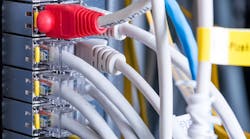Putting smart technologies inside new construction projects can be a relatively easy task. The technology infrastructure—including physical space and accommodations—can be planned and integrated into the building architecture.
For older, legacy buildings, things can get more complicated. But with preparation and an awareness of common integration roadblocks, building owners and designers can transform any legacy property into a smart building. Here are four steps to help create the framework to achieve your smart-building retrofitting goals.
1. Identify MDF/IDF locations and requirements.
When planning to implement IT or OT into an existing building, one should look at the physical aspects of the integration. A successful smart building project must have a network infrastructure to connect into. This will likely require main distribution frame (MDF) and intermediate distribution frame (IDF) rooms. The MDF is typically a single location—often associated as the on-site data center—where the core networking equipment is housed inside a building or campus. IDFs are then dotted throughout the building or campus and contain the access-layer switches to which endpoints, such as IoT sensors and Wi-Fi equipment, connect.
Depending on the type of cabling used and the throughput required, the MDF and IDF locations must be located within certain distances of each other to adhere to cable-distance limitations. For example, the maximum cable length of gigabit Ethernet over Category 5e or higher rated cabling is 100 meters (328 feet). IDF locations must be such that all building corners can be reached, or else certain areas will lack wired network connectivity.
Infrastructure architects must carefully note the types and numbers of network and IoT devices that require both power and cooling. Failing to do so can cause situations where smart building projects fail due to a lack of electricity or because the MDFs/IDFs run too hot and damage equipment. In a legacy building, addressing heating and cooling requirements might require tapping into existing, buildingwide HVAC systems or adding wall-mounted or portable cooling units.
2. Understand physical cabling paths and limitations.
In-building cable plants have both vertical and horizontal cabling needs. Vertical cabling interconnects the one or more MDF locations to the IDF locations; it is also referred to as uplink cabling because IDF switches use it to transport traffic from one network switch to another. Consequently, vertical cabling typically has higher speed and distance requirements; fiber optic and 10, 40, or 100 Gbps fiber interfaces are commonly used.
Ideally, the MDF and associated IDFs are stacked atop each other and the vertical cabling between floors can be run easily. However, in older buildings where this is not possible, cabling that zigzags across a building, creating longer cable runs, is not uncommon. Again, one must take care to ensure the cable path from an MDF to the IDFs does not exceed the maximum length of both the cabling and transport type.
Horizontal cabling refers to the cabling that extends from IDF locations to the various IT/OT endpoints and IoT sensors to the building LAN (local area network). It most commonly comprises twisted-pair copper cabling although fiber can be used in some scenarios.
3. Use wireless connectivity as needed.
When the existing building has little room for either horizontal or vertical cable runs, wireless networking technologies offer a great alternative to wired connectivity. Wi-Fi is typically the preferred wireless method of choice.
That said, private 5G technologies are gaining momentum in smart buildings for benefits they can offer over Wi-Fi: an increase in signal propagation, lower latency, guaranteed performance, and improved data security.
4. Connect and manage legacy OT systems.
Existing buildings will likely have older operational technologies that may not be compatible with modern networks. These existing OT systems must be identified and retrofitted to work within a modern infrastructure. Connecting legacy OT to an in-building IP LAN may require the use of specialized gateways that bridge proprietary OT systems onto a standard Ethernet or Wi-Fi LAN. Additionally, the integration team might deploy a unified first- or third-party management platforms to centrally control both the existing and new OT systems.



